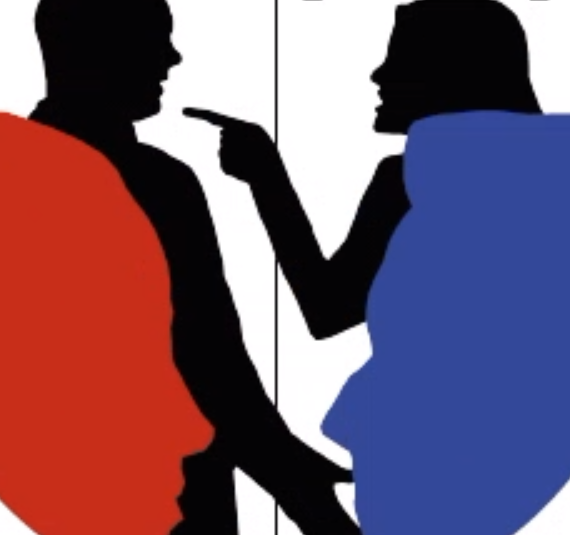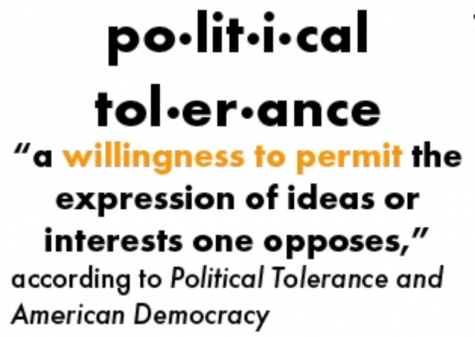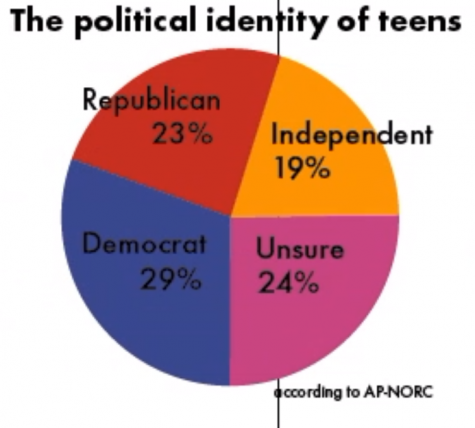Your donation will support the student journalists of Walnut Hills High School. Your contribution will allow us to purchase equipment, cover our annual website hosting, printing costs and offset competition and conferences fees for students.
Pride and Prejudice, Political Tolerance
April 15, 2019

WHHS students come from many political, racial, and ethnic backgrounds. Despite this, many find it difficult to accept other political viewpoints.
Arranged in six rows containing five desks each, WHHS students face their teacher, some engaged in the lecture while others fight off sleep. The classroom is quiet until the teacher asks a question. Eventually the floor is opened for discussion, and politics inevitably enter into the conversation.
Different versions of similar opinions fly around the room, rousing nods and smiles. Then, someone interjects with a divergent, controversial thought.
Previously drooping heads swivel to gape at the now heated debate that is happening before their eyes. It seems someone has taken a red marker and drawn a thick line down the center of the classroom; old allies turn into enemies.
As the debate escalates, one can see the sides of the battle are not equal. The more homogeneous, popular idea is gaining steam, fast, and with each new supporter their battle cry gets louder. They corner the supporters of the different, less popular idea and confront them with their power in numbers. It seems the popular side is surely going to win, closing in on the opponents fast.
But then the bell rings, and both sides retreat. The tension dispels quickly, and the students return to normal life as they pour into the halls.
What is political tolerance and what do researchers say about it?
Sitting in that unnoticeably yellow classroom, within these somewhat more noticeably yellow hallways, under this blindingly noticeable yellow sun, WHHS students are learning. Each day they open their mind to new ideas, whether it be a different theorem in math, a strange law in science or an out-of-the-ordinary rhetorical strategy in English.
Students consider new ideas, even if they do not agree with them; they are tolerant.

Political tolerance, just like other forms of tolerance, involves the respecting of ideas that differ from one’s own. Political tolerance, according to a 2001 study published by the Educational Resources Information Center, is “the willingness to extend basic rights and civil liberties to persons and groups whose viewpoints differ from one’s own.”
Applied in the United States, it can be seen in the concept that the majority party is in control of the White House, yet under their regime, minority party members’ rights are still protected. However, political tolerance does not always manifest itself on such a large scale.
Under the Constitution, each American possesses certain “individual rights,” which entitle them to their own opinions and beliefs. Of course, due to the size and resulting diversity that the United States boasts, not every person has the same set of views. Despite this, these same “individual rights” allow people with different beliefs to express them and be respectful of others. This, too, is political tolerance.
Because of this, many, including researches at Vanderbilt University, have labeled political tolerance as a “fundamental principle of democracy,”, but those researchers say it has been on the decline in the United States since the early 2000s.
What factors impact WHHS’ political discourse?
WHHS is a magnet, drawing students from every urban neighborhood in Cincinnati, as well as students from outside the school district. The diversity of the student body is one of the school’s most celebrated traits.
When universities and institutions tout diversity statistics, they aim to present themselves as accepting communities where new ideas lead to progress. In this way, diversity is an attractive idea. WHHS embraces students of different cultures, socioeconomic standings, religions, races, genders and sexualities. In addition to these, and arguably because of them, WHHS is also diverse politically.

The location of WHHS in a major city in a swing state also affects its political discourse.
A 2019 study by The Atlantic measured the political prejudice of every county in America. Hamilton County falls in most prejudiced category, “more prejudiced” against the political “other” than 81 percent of counties. It is in most prejudiced category against both Republicans and Democrats.
The study attributes this polarization, seen in many large cities, to the lack of interaction between parties: “As politics have become more about identity than policy, partisan leanings have become more about how we grew up and where we feel like we belong.”
For example, the report found that the most prejudiced community was Boston, where nine in 10 married couples share political beliefs and eight in 10 neighborhoods had a common political party. The least prejudiced places were not necessarily the most politically diverse areas, but the areas where people of different parties are more likely to live and work together.
The political culture of WHHS may also be shaped by the broader generational trend of young people toward political action.
Research shows that the internet has raised a politically-aware generation. A study conducted by The Associated Press-NORC Center for Public Affairs found that American teens between age 13 and 17 who use Twitter and Instagram are more likely to participate in a protest and share political beliefs online than those who do not use the platforms.
Adolescent development, a period now believed to extend into a person’s late twenties, also contributes to the social and political trends seen in young adults. According to Ronald Dahl, Director of the Institute of Human Development at the University of California, Berkeley, the development of an adolescent’s identity starts to rely less on parental influence and more on peer acceptance. Cognitive developments can lead to both egocentrism and self-consciousness.
While adolescent development is still a relatively new field, it is important to consider the age group of WHHS students and the newness of their social identities. When students argue about politics, they are forging their identities as their brains seek a sense of both individuality and belonging in a group.
Do we need political tolerance?
Many wonder if political tolerance has limits, or if it is even necessary. Where is the line between being tolerant and being complicit?
“Political intolerance is not the issue,” Mimi Montefiore, ‘21, said, “The people who feel like it is are politicizing others’ existence and pretending that getting called out for being racist, homophobic and/or xenophobic is somehow an attack on their politics. It’s not, it’s telling them that they can’t be rude and not expect to get some social backlash.”
This presents an important distinction; political tolerance does require respect and civil discourse, but it does not require agreement. People struggle with protecting others’ rights to disagree with them.
“Tolerance of [an] individual versus tolerance of political parties is an extreme variation,” an anonymous student said. “One questions the personal morality of a single student, while the other is near meaningless and forces individuals to be intolerant of the other group.”
Additionally, there are some who do not feel that political intolerance is present at WHHS. Not every student interacts with politics, and some report that they simply have not experienced a problem.

How do we build a healthy political climate at WHHS?
Ultimately, the definition of a healthy political climate is a matter of opinion. Assuming that the goal is constructive political discussion, how can it be achieved? According to Patricia Avery, author of “Developing Political Tolerance”, classroom discussion can have a lasting impact: “It appears that when students see that their teachers are interested in multiple perspectives, when they feel their own ideas are respected, and when they regularly listen to different viewpoints, they are more tolerant of diverse beliefs.”
Teachers are not the only people who can work towards creating a culture of political tolerance. Students can also spark this change within their own classrooms. They can embrace political passion from their peers, while simultaneously expecting civility and a respectful environment.
“I believe political tolerance is one of the only ways we can create a healthy environment,” James Montelisciani, ‘21, said, “Not accepting others’ views doesn’t equate to progress.”
In a way, the political engagement of WHHS students points toward a bright and politically aware future in America. However, this political activism will not lead to progress if we do not also cultivate a respect for discussion.